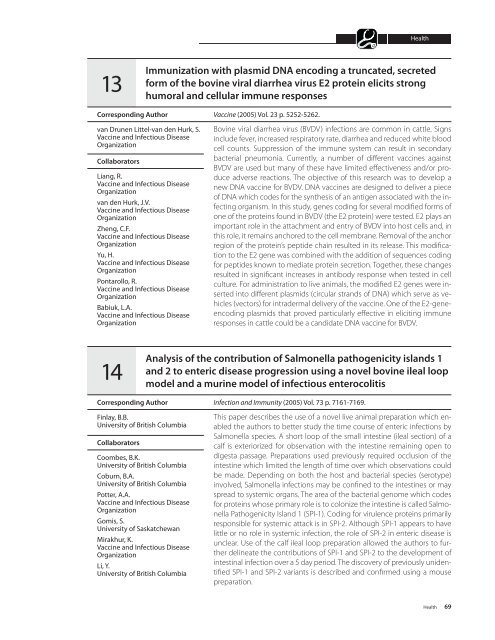A52-75-2007E.pdf - AgroMedia International Inc
A52-75-2007E.pdf - AgroMedia International Inc
A52-75-2007E.pdf - AgroMedia International Inc
You also want an ePaper? Increase the reach of your titles
YUMPU automatically turns print PDFs into web optimized ePapers that Google loves.
Health13Immunization with plasmid DNA encoding a truncated, secretedform of the bovine viral diarrhea virus E2 protein elicits stronghumoral and cellular immune responsesCorresponding Authorvan Drunen Littel-van den Hurk, S.Vaccine and Infectious DiseaseOrganizationCollaboratorsLiang, R.Vaccine and Infectious DiseaseOrganizationvan den Hurk, J.V.Vaccine and Infectious DiseaseOrganizationZheng, C.F.Vaccine and Infectious DiseaseOrganizationYu, H.Vaccine and Infectious DiseaseOrganizationPontarollo, R.Vaccine and Infectious DiseaseOrganizationBabiuk, L.A.Vaccine and Infectious DiseaseOrganizationVaccine (2005) Vol. 23 p. 5252-5262.Bovine viral diarrhea virus (BVDV) infections are common in cattle. Signsinclude fever, increased respiratory rate, diarrhea and reduced white bloodcell counts. Suppression of the immune system can result in secondarybacterial pneumonia. Currently, a number of different vaccines againstBVDV are used but many of these have limited effectiveness and/or produceadverse reactions. The objective of this research was to develop anew DNA vaccine for BVDV. DNA vaccines are designed to deliver a pieceof DNA which codes for the synthesis of an antigen associated with the infectingorganism. In this study, genes coding for several modified forms ofone of the proteins found in BVDV (the E2 protein) were tested. E2 plays animportant role in the attachment and entry of BVDV into host cells and, inthis role, it remains anchored to the cell membrane. Removal of the anchorregion of the protein’s peptide chain resulted in its release. This modificationto the E2 gene was combined with the addition of sequences codingfor peptides known to mediate protein secretion. Together, these changesresulted in significant increases in antibody response when tested in cellculture. For administration to live animals, the modified E2 genes were insertedinto different plasmids (circular strands of DNA) which serve as vehicles(vectors) for intradermal delivery of the vaccine. One of the E2-geneencodingplasmids that proved particularly effective in eliciting immuneresponses in cattle could be a candidate DNA vaccine for BVDV.14Analysis of the contribution of Salmonella pathogenicity islands 1and 2 to enteric disease progression using a novel bovine ileal loopmodel and a murine model of infectious enterocolitisCorresponding AuthorFinlay, B.B.University of British ColumbiaCollaboratorsCoombes, B.K.University of British ColumbiaCoburn, B.A.University of British ColumbiaPotter, A.A.Vaccine and Infectious DiseaseOrganizationGomis, S.University of SaskatchewanMirakhur, K.Vaccine and Infectious DiseaseOrganizationLi, Y.University of British ColumbiaInfection and Immunity (2005) Vol. 73 p. 7161-7169.This paper describes the use of a novel live animal preparation which enabledthe authors to better study the time course of enteric infections bySalmonella species. A short loop of the small intestine (ileal section) of acalf is exteriorized for observation with the intestine remaining open todigesta passage. Preparations used previously required occlusion of theintestine which limited the length of time over which observations couldbe made. Depending on both the host and bacterial species (serotype)involved, Salmonella infections may be confined to the intestines or mayspread to systemic organs. The area of the bacterial genome which codesfor proteins whose primary role is to colonize the intestine is called SalmonellaPathogenicity Island 1 (SPI-1). Coding for virulence proteins primarilyresponsible for systemic attack is in SPI-2. Although SPI-1 appears to havelittle or no role in systemic infection, the role of SPI-2 in enteric disease isunclear. Use of the calf ileal loop preparation allowed the authors to furtherdelineate the contributions of SPI-1 and SPI-2 to the development ofintestinal infection over a 5 day period. The discovery of previously unidentifiedSPI-1 and SPI-2 variants is described and confirmed using a mousepreparation.Health 69





